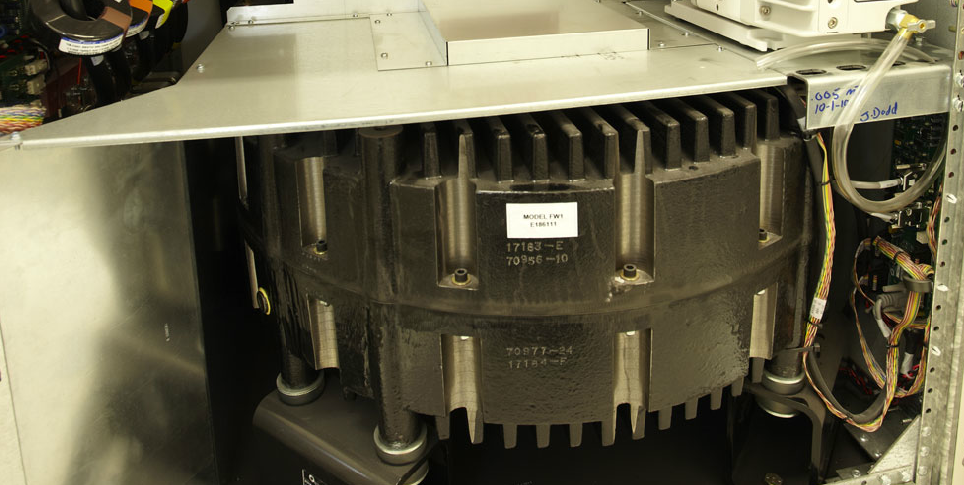Ancient technology for new data centre UPS designs
Fri, 14 Sep 2012
data centres
A recent white paper from 451 Research offers a fascinating insight into the evolution of UPS energy storage technologies for data centre mass-market, revealing an increasing openness to an ancient, yet also state of the art, form of energy conservation and energy transfer: The flywheel
Jason Schafer’s discusses the interplay between market forces and improved kinetic UPS technologies in the data centre UPS industry. Entitled The beginning of the end of the incumbent UPS, the report envisions large scale deployments of flywheel based UPS systems to replace traditional rechargeable chemical battery UPS systems.
Flywheel systems work by storing kinetic energy in the momentum of a heavy wheel spinning at very high speeds. During normal energy loads, momentum is maintained by a motor which itself is powered directly from the grid. When an outage occurs, the wheel continues to spin providing kinetic energy to be converted back to electrical power. This power source temporarily carries the data centre load as well as kick-starts the back-up generator system.

Rotary UPS. No battery, no chemicals, high efficiency
Schafer distinguishes between two kinds of flywheel based UPS: a purely mechanical Rotary UPS derives its power solely from the kinetic energy of the spinning object. Flywheel UPS systems combine flywheels (kinetic energy) with batteries (chemical energy) to benefit from advantages of both systems: during an outage, power is provided from the battery, which in turn is temporarily recharged from the flywheel.
| Flywheel UPS | Rotary UPS | Battery UPS | |
|---|---|---|---|
| Runtime | 10-30 seconds | 20-60 seconds | 10-20 minutes |
| Efficiency | 98%+ | 95-97% | 92-95% |
| Cost | Higher capex | Lower (for same runtime) | Long term expense |
| Maintenance | Lowest | Fairly low | Higher |
| Eco Credentials | Excellent | Very good | Disposal issues |
Comparison of UPS technologies
Schafer claims that traditional non-flywheel, battery only based systems are losing popularity. The key to these developments is the engineering improvements to both the flywheels and generator systems: modern generators are able to start much more quickly (taking full building load in 5-30 seconds) than their predecessors (some taking upwards of a minute). So whilst battery systems can provide power for up to 20 minutes runtime during a power outage, unlike flywheel based systems which only give runtimes of 15 to 60 seconds, the higher runtime is becoming increasingly unnecessary. These shorter runtimes also allow for cheaper and more environmentally friendly UPS infrastructure. One estimate by Vycon, a Flywheel UPS manufacturer, states:
Over a 20 year lifespan… cost savings from a flywheel versus a five-minute valve-regulated lead-acid [VRLA] battery bank can range from $100,000 to $200,000 (£66k to £133k) per flywheel deployed. [Tech Week Europe]
Added to this, energy efficiencies are demonstrably greater: flywheel systems provide 95-98% efficiency. Purely battery systems, on the other hand, typically only provide around 92-95% efficiencies, as well as higher recycling costs or environmental disposal issues.
Market demand for lower cost, greener facilities has prompted many new data centres to make the flywheel design choice. N+1 Rotary UPS have been deployed in the new QiComm Tutis Point Docklands data centre, a recent welcome addition to the ConnetU network and London colocation. QiComm Business Manager, Allan Rooms is emphatic:
Even at low load we are experiencing efficiency ratings of over 95% . Not only is the system excellent value for money but the working practices and benefits it brings is helping us further our business
Schafer’s view of the evolving UPS marketplace is convincing, and so too is the evidence we find in east London, that real world demand for ever more cost effective ICT hosting is pushing UPS technologies to respond. He summarises:
Convention is being disregarded, and loyalty to a particular piece of gear or technology method is softening. Consequently, UPS technologies and build methods are already starting to be disrupted.
Come join us on: